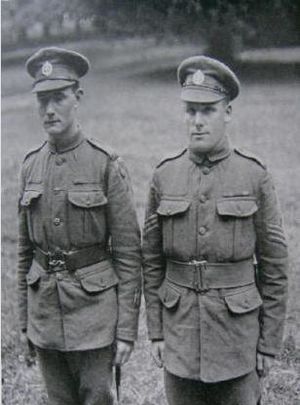William Beesley facts for kids
Quick facts for kids
William Beesley
|
|
|---|---|

William Beesley (left) and William Gregg
|
|
| Born | 5 October 1895 Gresley, Derbyshire |
| Died | 23 September 1966 (aged 70) Abergavenny, Monmouthshire |
| Buried |
St Paul's Cemetery, Coventry
|
| Allegiance | |
| Service/ |
|
| Years of service | 1914–1919 |
| Rank | Sergeant |
| Unit | The Rifle Brigade King's Royal Rifle Corps Royal Artillery |
| Battles/wars | World War I World War II |
| Awards | |
William Beesley (born October 5, 1895 – died September 23, 1966) was an English soldier. He received the Victoria Cross, which is the highest award for bravery in the face of the enemy. This special medal can be given to soldiers from the British and Commonwealth forces.
William Beesley's Bravery
William Beesley was 22 years old when he showed incredible courage during World War I. He was a private in the 13th Battalion of The Rifle Brigade (Prince Consort's Own). This brave event happened on May 8, 1918, in Bucquoy, France.
A Heroic Act in World War I
During a battle, Private Beesley's platoon (a small group of soldiers) lost its leader and all its section commanders. They were all killed. William Beesley, even though he was just a private, took charge of the group.
He bravely ran towards an enemy post all by himself. He shot four enemy soldiers and captured six others. He then sent these prisoners back to his own lines.
After that, William Beesley and another soldier brought their Lewis gun (a type of machine gun) into action. They fired at the enemy, causing many casualties. They held their position for four hours. Then, the other soldier was wounded.
Private Beesley was left alone, but he kept fighting. He held his position by himself until nightfall. When it was dark, he returned to his original line. He brought the wounded soldier and the Lewis gun with him. He kept using the gun until the fighting calmed down.
After the War
Because of his amazing bravery, William Beesley was awarded the Victoria Cross. Later in his military career, he became a sergeant.
Today, you can see his Victoria Cross medal. It is on display at the Royal Green Jackets (Rifles) Museum in Winchester, England.

